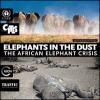Convention on International Trade in Endangered Species of Wild Fauna and Flora (CITES), Secretariat
Criteria for listing species on the CITES appendices and the IUCN Red List : a technical workshop
Latin American wildlife trade laws
Elephants in the dust : the African elephant crisis : a rapid response assessment

The African elephant, the largest remaining land mammal on the planet, is facing the greatest crisis in decades. Reports of mass elephant killings in the media vividly illustrate the situation across many African elephant range states. This publication provides an overview of the current state of the African elephant alongside recommendations for action to ensure its protection.
L'évolution de la CITES : ouvrage de référence sur la Convention sur le Commerce International des Espèces de Faune et de Flore sauvages menacées d'extinction

This comprehensive publication presents a history of the evolution of CITES. It begins with the basics and guides the reader through its complex structure. The provisions of the Convention are clearly highlighted in the book, and the numerous resolutions and decisions are explained.
The evolution of CITES : a reference to the Convention on International Trade in Endangered Species of Wild Fauna and Flora

This comprehensive publication presents a history of the evolution of CITES. It begins with the basics and guides the reader through its complex structure. The provisions of the Convention are clearly highlighted in the book, and the numerous resolutions and decisions are explained.
Elephant meat trade in Central Africa : Republic of Congo case study

The IUCN/SSC African Elephant Specialist Group AfESG) has been charged by MIKE with implementing a project to investigate the linkages between the elephant meat trade and larger social and economic dynamics at play, including, but not limited to, ivory trade, logging (legal and illegal), mining, infrastructure development, global economic trends, law enforcement at the national and international level, and community forest governance.
Elephant meat trade in Central Africa : Democratic Republic of Congo case study

The objective of the study is to enhance knowledge of contemporary elephant bushmeat market dynamics, patterns and trends in north-eastern DRC and determine the impact of elephant meat trade on the Okapi Faunal Reserve (OFR) population.
Elephant meat trade in Central Africa : Central African Republic case study

This pilot study was instigated by the Monitoring of Illegal Killing of Elephants (MIKE) programme of the Convention on International Trade in Endangered Species (CITES) and is being implemented by the IUCN African Elephant Specialist Group (AfESG). It seeks to explore the many causes and motivations driving the illegal killing of elephants, particularly the trade and commerce of elephant meat and ivory.
Elephant meat trade in Central Africa : Cameroon case study

The pilot study presented in this report is part of an International Union for Conservation of Nature (IUCN) African Elephant Specialist Group (AfESG) project initiated by the Monitoring the Illegal Killing of Elephants (MIKE) programme of the Convention on International Trade in Endangered Species (CITES). The project aims to improve understanding of the impact of elephant meat trade on elephant populations in Central Africa.
